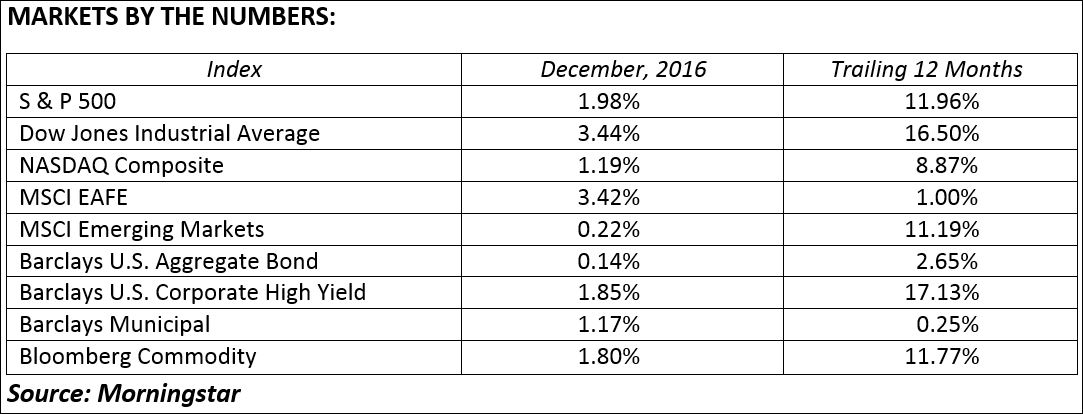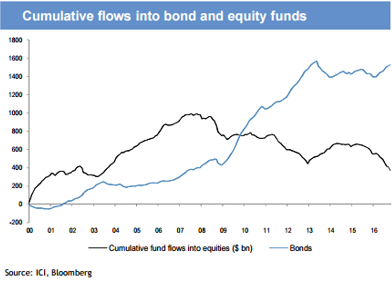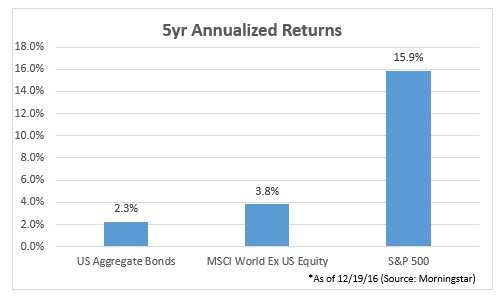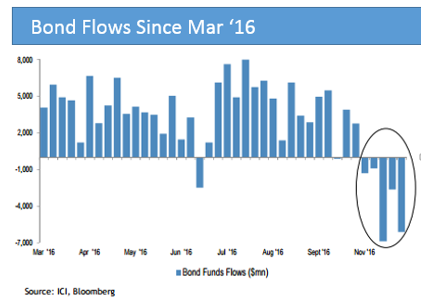Precious Metals were among the best performing asset classes in 2016 following three years of underperformance. Why would we be interested in precious metals at this juncture? Over long periods of time different assets perform differently under varying market and economic conditions.
Each of the four primary precious metals — gold, silver, platinum and palladium — has its own key drivers of supply and demand. No one metal continuously leads the others and each can be volatile alone, so a basket of all four precious metals is preferred to owning just one. In this analysis, we will address our outlook for the price of each.
Gold is the most widely traded of the precious metals and is considered a store of value in periods of weakening local currencies, rising inflation, increased market volatility and black swan events (i.e., BREXIT, perhaps spring ’17 elections in France, fall ’17 elections in Germany). Rising interest rates will work against the price of gold IF they are increasing in real terms, that is, after taking into account the rate of inflation.
Alternatively, the rising U.S. dollar versus other currencies following Trump’s election pressured the price of gold in the final weeks of 2016. The thinking was that rising tariffs and other protectionist moves under our new president would erode overseas growth going forward. In an increasingly interconnected global economy, we believe this is less likely than the rhetoric to date would indicate. In fact, gold has been one of the best performing assets at the start of 2017, up by 5 percent, on top of a 9 percent gain for all of last year.
On the supply side, gold mine production is expected to rise very slightly this year to peak levels* before dropping in the coming years as miners continue to cut investments. We believe investor demand will rise in a year of:
- low real interest rates
- increasing inflation for inputs and wages
- rising political uncertainty around the world
Tempering the demand for gold will likely be continuing pressure in a major key market, India, where there has been a focus on currency corruption. Taken together, we believe the price of gold still has the potential for 5-10% gains over the remainder of 2017.
Silver production is expected to drop 1 percent this year after ten years of increases.* We expect production will continue to drop in the coming years based on cuts in mining operations. From the demand side, we believe global economic recovery (infrastructure and industrial activity plus rising costs of inputs) will be favorable for holders of silver. Following a 12 percent gain in 2016, silver could rise double-digits again this year in our opinion.
Platinum supply is expected to decline 3 percent this year* following a similar decline last year when prices for platinum were up just 1 percent. Demand meanwhile is expected to be flat or up slightly in 2017 based on global economic recovery including rising European and Chinese auto production.
Palladium supply deficits have occurred in each of the past four years, and are expected to persist for the next few years.**** Here we are forecasting continued increases in demand given our outlook for rising U.S. infrastructure spending, accelerating global auto sales and global economic growth. On top of a 21 percent gain last year, we expect palladium prices to rise again in 2017.
Nevada Retirement Planners offers an actively managed Precious Metals strategy to complement stock and bond allocations for many investors. We also include precious metals in our ETF Endowment Series. Please contact us to discuss how precious metals may be applicable to your long term financial goals and objectives.
Sources:
* Metals Focus Ltd.
** Metals Focus Ltd.
*** Metals Focus Ltd.
**** Johnson Matthey, November 2016
To expand on these Market Reflections or to discuss any of our investment portfolios, please do not hesitate to reach out to us at 775-674-2222




